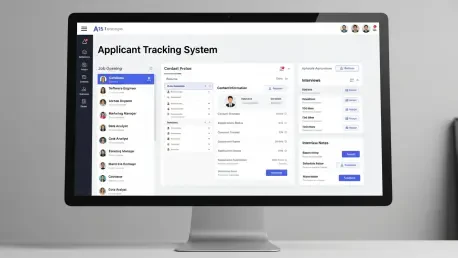Imagine a local government struggling to fill critical positions, with hiring processes dragging on for nearly a year, leaving staff overwhelmed and public services delayed, a scenario that highlights the urgent need for efficient recruitment solutions. Applicant Tracking Systems (ATS) have emerged as a transformative technology, automating and streamlining the hiring process to address such inefficiencies. This review delves into the core functionalities, recent advancements, real-world impact, and future potential of ATS, with a particular focus on its role in modernizing public sector hiring.
Understanding Applicant Tracking Systems
At its core, an ATS is a software solution designed to optimize the recruitment process by automating key tasks such as job postings, application screening, and candidate tracking. This technology serves as a centralized platform where employers can manage the entire hiring lifecycle, from advertising vacancies to onboarding new hires. By digitizing these processes, ATS eliminates much of the manual effort traditionally associated with recruitment, offering a systematic approach to talent acquisition.
The relevance of ATS extends far beyond mere convenience, fitting into the broader technological landscape of workforce modernization. In an era where inefficiencies in traditional hiring methods—such as paper-based applications and manual data entry—hinder organizational growth, ATS provides a critical tool to address these challenges. Its adoption across industries, especially in the public sector, highlights its capacity to enhance operational speed and accuracy, paving the way for more agile and responsive hiring practices.
Core Features of Applicant Tracking Systems
Automation of Job Postings and Applications
One of the standout capabilities of ATS lies in its ability to automate the distribution of job openings across multiple platforms, including job boards and social media channels. This feature ensures that vacancies reach a wider audience with minimal effort from HR teams. By handling large volumes of incoming applications through a single interface, the system significantly reduces the administrative burden that often slows down recruitment staff.
The performance of ATS in this area is notable for accelerating the hiring timeline. Organizations can post roles instantly and receive applications in real time, ensuring consistency in outreach and engagement with potential candidates. This automation not only saves time but also enhances the visibility of opportunities, making it easier to attract diverse talent pools in competitive markets.
Candidate Screening and Tracking
Another pivotal feature of ATS is its capacity to filter resumes based on predefined criteria such as keywords, qualifications, and experience levels. This functionality allows recruiters to quickly narrow down applicant pools to the most suitable candidates without manually reviewing every submission. Additionally, the system tracks candidates through each stage of the hiring process, providing a clear overview of their progress.
From a technical standpoint, ATS employs algorithms to match candidate profiles with job requirements, improving the accuracy of selections. Real-world usage demonstrates its effectiveness in identifying qualified individuals efficiently, often reducing the time spent on initial screenings by a substantial margin. This precision helps organizations focus their resources on engaging with top-tier talent rather than sifting through irrelevant applications.
Recent Innovations in ATS Technology
The evolution of ATS has been marked by significant advancements, particularly in integration with cloud-based platforms like Taleo by Oracle. These systems offer scalable solutions that allow organizations to access recruitment tools from anywhere, enhancing flexibility and collaboration among distributed teams. Such innovations ensure that data is securely stored and easily retrievable, supporting seamless operations.
Emerging trends also include the incorporation of AI-driven candidate matching, which goes beyond basic keyword searches to predict compatibility based on behavioral and skill-based data. Enhanced user interfaces have made these tools more accessible, even for those less familiar with technology. Additionally, there is a growing emphasis on user training and change management to facilitate smooth adoption across diverse organizational environments.
A key focus of recent developments is addressing the human element of technology implementation. By prioritizing intuitive design and comprehensive support resources, modern ATS solutions aim to minimize disruption during transitions. This approach ensures that staff at all levels can leverage the system effectively, maximizing its potential benefits.
Real-World Applications and Impact
The practical impact of ATS is vividly illustrated in the public sector, particularly in local government modernization efforts. In St. Louis, Missouri, the adoption of an ATS slashed hiring times from nearly a year to just 2-3 months. This dramatic reduction enabled the city to fill critical positions faster, directly improving service delivery to residents while alleviating pressure on existing staff.
Unique use cases further highlight the value of ATS, such as the digitization of over 20,000 applications, which eliminated the need for cumbersome paperwork and postage. This transition resulted in annual cost savings exceeding $250,000 for the city. Beyond financial benefits, the system allowed staff previously tasked with manual data entry to transition into higher-value roles like recruiting and data analysis, enhancing overall productivity.
The broader implications of ATS adoption are evident in how it reshapes workforce dynamics. By automating repetitive tasks, the technology frees up human resources teams to focus on strategic initiatives, fostering a more engaged and efficient workplace. Such transformations underscore the potential of ATS to drive systemic improvements across various sectors.
Challenges and Limitations of ATS Implementation
Despite its advantages, implementing ATS is not without challenges, particularly in environments resistant to change. Staff often express concerns about job displacement due to automation, fearing that their skills may become obsolete. This apprehension can hinder adoption and create tension within organizations undergoing digital transformation.
Additional obstacles include the burden of maintaining new technological infrastructure and the complexity of overhauling legacy systems. These issues require significant investment in both time and resources, often straining budgets and testing patience. Without proper planning, such transitions can lead to operational disruptions that undermine the intended benefits of ATS.
Efforts to mitigate these limitations have shown promise, as seen in St. Louis, where comprehensive training programs and stakeholder engagement played a crucial role. Phased implementation strategies also help ease the shift, allowing organizations to address issues incrementally. These approaches emphasize the importance of a human-centered focus in navigating the challenges of technology adoption.
Future Prospects of Applicant Tracking Systems
Looking ahead, ATS technology holds immense potential for further innovation, particularly through advancements in AI for predictive hiring analytics. Such capabilities could enable organizations to anticipate workforce needs and identify candidates who are not only qualified but also likely to thrive long-term. This shift toward data-driven decision-making could redefine recruitment strategies.
Deeper integration with other HR tools, such as payroll and performance management systems, is another promising direction. This convergence would create a more holistic approach to talent management, streamlining processes across the employee lifecycle. As these integrations mature, organizations can expect greater coherence in their HR operations, enhancing overall efficiency.
The long-term impact of ATS on workforce dynamics and public sector service delivery appears substantial. By continuing to evolve, this technology could play a pivotal role in shaping adaptable, tech-savvy organizations ready to meet future challenges. Its ability to balance automation with human insight will likely determine its enduring relevance in a rapidly changing landscape.
Conclusion and Overall Assessment
Reflecting on the journey of ATS, its role as a transformative tool in recruitment becomes evident through its ability to streamline processes and boost operational efficiency. The technology has proven itself as a reliable solution, delivering measurable benefits across diverse sectors. Its impact on modernizing hiring practices, especially in the public sector, stands out as a testament to its value.
Moving forward, organizations should prioritize robust change management strategies to address adoption challenges, ensuring staff are equipped to embrace these tools. Investing in ongoing training and support will be essential to sustain momentum. As ATS continues to evolve, stakeholders must remain proactive in exploring integrations and AI advancements to unlock its full potential for future workforce needs.









